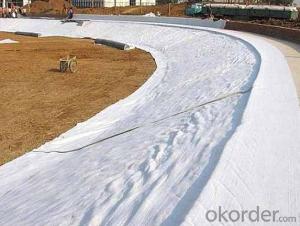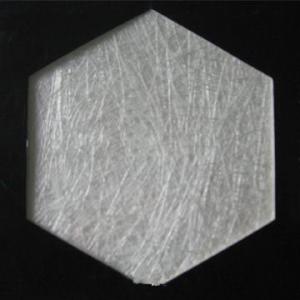Kain Geotextile Non Woven Filter Cloth for Road, Railway, Tunnel Canal
- Loading Port:
- Tianjin
- Payment Terms:
- TT OR LC
- Min Order Qty:
- 1000 m²
- Supply Capability:
- 50000 m²/month
OKorder Service Pledge
OKorder Financial Service
You Might Also Like
Nonwoven Filter Cloth Hatching Eclosion forRoad Railwayfor Road Railway Tunnel Canel Tunnel Canel; Filament Geotextile
It has bigger pore between fibers than other textiles, made from PET, PP, Rfibers by nowoven tech
Nology, with spray adhesive and drying process.
Types of Nonwoven FilterCloth Hatching Eclosion for Road Railwayfor Road Railway Tunnel Canel TunnelCanel
L. Lndustrial filter cloth
2. Filter bag, dust removal and filter bag at high temperature
3. Air filter cloth
Property of NonwovenFilter Cloth Hatching Eclosion for Road Railwayfor Road Railway Tunnel CanelTunnel Canel
I. Flat surface, high strength, bigger pore, excellent drainage property
2. Filter, dust removal and antistatic property
3. Thermo stability, anti-corrosion and fire resistance
Application of Nonwoven Filter Cloth Hatching Eclosion for Road Railwayfor Road RailwayTunnel Canel Tunnel Canel
I. Air filters for household appliances
2. Oil filters for motor vehicles
3. Dust precipitation in environmental field
- Q: How do geotextiles improve the performance of geosynthetic tubes?
- Geotextiles improve the performance of geosynthetic tubes by providing reinforcement and filtration capabilities. They act as a barrier, preventing soil particles from entering and clogging the tubes while allowing water to pass through. This helps maintain the structural integrity and efficiency of the tubes, enhancing their overall performance.
- Q: Are geotextiles suitable for use in wetlands?
- Yes, geotextiles are suitable for use in wetlands. They are commonly used to stabilize soil, control erosion, and promote vegetation growth in wetland areas. Geotextiles can help retain moisture, filter water, and provide support to prevent soil movement. Additionally, they are often biodegradable or made from natural materials, making them environmentally friendly and suitable for use in wetland ecosystems.
- Q: Geotextile geotextile geotextile construction geotextile specific application
- Geotextile in the construction of the main building is to protect the concrete: 1, in the summer construction of geotextile is to protect the concrete in the water; 2, in the winter construction of geotextile that can protect the concrete moisture also play a role in insulation.
- Q: Is LDPE a geotextile or geomembrane? Answer!
- Geomembrane series, belonging to low density geomembrane
- Q: How do geotextiles prevent soil erosion on slopes?
- Geotextiles prevent soil erosion on slopes by providing a protective barrier that stabilizes the soil and prevents it from being washed away by water runoff. They help to distribute the weight of rainfall evenly across the slope, reducing the erosive force and promoting water infiltration into the soil. Additionally, geotextiles retain sediment particles, preventing their movement and maintaining the integrity of the slope.
- Q: Can geotextiles be used for reinforcement of railway embankments?
- Yes, geotextiles can be used for reinforcement of railway embankments. Geotextiles are often used in civil engineering projects to improve the stability and performance of soil structures. In the case of railway embankments, geotextiles can be placed beneath the ballast layer to enhance the load-bearing capacity of the soil, prevent erosion, and improve overall embankment stability.
- Q: The technical parameters of woven geotextile
- Test items / specifications 0400 Remarks breaking strength (longitudinal) KN / m ≥ 17. Breaking strength (horizontal) KN / m ≥ no special requirements by the meridional 0.7 / 1 longitudinal and transverse elongation at break% ≤ 25 vertical and horizontal trapezoidal torn Strength, KN ≥ 0.180.200.270.340.410.480.600.72 vertical and horizontal CBR top breaking strength, KN ≥ 1.41.62.43.24.04.86.07.5 equivalent aperture O95 (O95) mm0.07-0.5 vertical permeability coefficient cm / sK × (10-1-10-4) K = 1.0-9.9
- Q: Can geotextiles be used in agricultural drainage systems?
- Yes, geotextiles can be used in agricultural drainage systems. They are commonly used as a filter fabric to prevent soil particles from clogging drainage pipes while allowing water to pass through. Geotextiles help improve the efficiency and longevity of agricultural drainage systems by preventing soil erosion and maintaining the proper flow of water.
- Q: In the laying of composite geotextile water layer, what is wf115-0.2mm type
- Supply of composite geotextile, geomembrane.
- Q: How do geotextiles help in separating different soil layers?
- Geotextiles help in separating different soil layers by acting as a barrier between them, preventing the intermixing of soil particles. This separation allows for better drainage and filtration, as well as reducing the risk of soil erosion and maintaining the stability of the soil structure.
Send your message to us
Kain Geotextile Non Woven Filter Cloth for Road, Railway, Tunnel Canal
- Loading Port:
- Tianjin
- Payment Terms:
- TT OR LC
- Min Order Qty:
- 1000 m²
- Supply Capability:
- 50000 m²/month
OKorder Service Pledge
OKorder Financial Service
Similar products
Hot products
Hot Searches
Related keywords



























